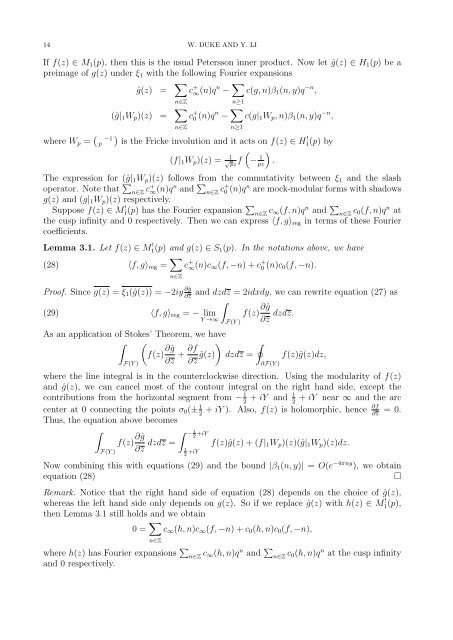Mock-modular forms of weight one - UCLA Department of Mathematics
Mock-modular forms of weight one - UCLA Department of Mathematics
Mock-modular forms of weight one - UCLA Department of Mathematics
You also want an ePaper? Increase the reach of your titles
YUMPU automatically turns print PDFs into web optimized ePapers that Google loves.
14 W. DUKE AND Y. LI<br />
If f(z) ∈ M 1 (p), then this is the usual Petersson inner product. Now let ĝ(z) ∈ H 1 (p) be a<br />
preimage <strong>of</strong> g(z) under ξ 1 with the following Fourier expansions<br />
where W p = (<br />
−1<br />
p<br />
ĝ(z) = ∑ n∈Z<br />
c + ∞(n)q n − ∑ n≥1<br />
c(g, n)β 1 (n, y)q −n ,<br />
(ĝ| 1 W p )(z) = ∑ c + 0 (n)q n − ∑ c(g| 1 W p , n)β 1 (n, y)q −n ,<br />
n∈Z<br />
n≥1<br />
)<br />
is the Fricke involution and it acts on f(z) ∈ H<br />
!<br />
1 (p) by<br />
( )<br />
(f| 1 W p )(z) = √ 1<br />
pz<br />
f − 1 .<br />
pz<br />
The expression for (ĝ| 1 W p )(z) follows from the commutativity between ξ 1 and the slash<br />
operator. Note that ∑ n∈Z c+ ∞(n)q n and ∑ n∈Z c+ 0 (n)q n are mock-<strong>modular</strong> <strong>forms</strong> with shadows<br />
g(z) and (g| 1 W p )(z) respectively.<br />
Suppose f(z) ∈ M 1(p) ! has the Fourier expansion ∑ n∈Z c ∞(f, n)q n and ∑ n∈Z c 0(f, n)q n at<br />
the cusp infinity and 0 respectively. Then we can express 〈f, g〉 reg in terms <strong>of</strong> these Fourier<br />
coefficients.<br />
Lemma 3.1. Let f(z) ∈ M ! 1(p) and g(z) ∈ S 1 (p). In the notations above, we have<br />
(28) 〈f, g〉 reg = ∑ n∈Z<br />
c + ∞(n)c ∞ (f, −n) + c + 0 (n)c 0 (f, −n).<br />
Pro<strong>of</strong>. Since g(z) = ξ 1 (ĝ(z)) = −2iy ∂ĝ<br />
∂z<br />
(29) 〈f, g〉 reg = − lim<br />
Y →∞<br />
and dzdz = 2idxdy, we can rewrite equation (27) as<br />
∫<br />
f(z) ∂ĝ<br />
∂z dzdz.<br />
F(Y )<br />
As an application <strong>of</strong> Stokes’ Theorem, we have<br />
∫ (<br />
f(z) ∂ĝ<br />
∂z + ∂f ) ∮<br />
∂z ĝ(z) dzdz =<br />
F(Y )<br />
∂F(Y )<br />
f(z)ĝ(z)dz,<br />
where the line integral is in the counterclockwise direction. Using the <strong>modular</strong>ity <strong>of</strong> f(z)<br />
and ĝ(z), we can cancel most <strong>of</strong> the contour integral on the right hand side, except the<br />
contributions from the horizontal segment from − 1 + iY and 1 + iY near ∞ and the arc<br />
2 2<br />
center at 0 connecting the points σ 0 (± 1 ∂f<br />
+ iY ). Also, f(z) is holomorphic, hence = 0.<br />
2 ∂z<br />
Thus, the equation above becomes<br />
∫<br />
f(z) ∂ĝ ∫ −<br />
1<br />
F(Y ) ∂z dzdz = 2 +iY<br />
f(z)ĝ(z) + (f| 1 W p )(z)(ĝ| 1 W p )(z)dz.<br />
1<br />
2 +iY<br />
Now combining this with equations (29) and the bound |β 1 (n, y)| = O(e −4πny ), we obtain<br />
equation (28)<br />
□<br />
Remark. Notice that the right hand side <strong>of</strong> equation (28) depends on the choice <strong>of</strong> ĝ(z),<br />
whereas the left hand side only depends on g(z). So if we replace ĝ(z) with h(z) ∈ M ! 1(p),<br />
then Lemma 3.1 still holds and we obtain<br />
0 = ∑ n∈Z<br />
c ∞ (h, n)c ∞ (f, −n) + c 0 (h, n)c 0 (f, −n),<br />
where h(z) has Fourier expansions ∑ n∈Z c ∞(h, n)q n and ∑ n∈Z c 0(h, n)q n at the cusp infinity<br />
and 0 respectively.
















